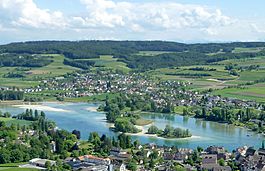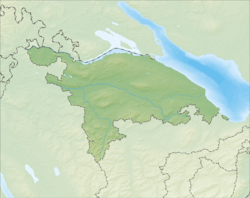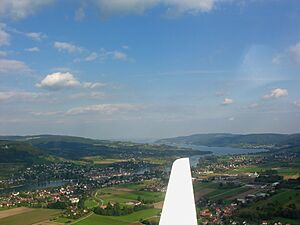Eschenz facts for kids
Quick facts for kids
Eschenz
|
||
|---|---|---|
 |
||
|
||
| Country | Switzerland | |
| Canton | Thurgau | |
| District | Frauenfeld | |
| Area | ||
| • Total | 12 km2 (5 sq mi) | |
| Elevation | 412 m (1,352 ft) | |
| Population
(Dec 2020 )
|
||
| • Total | 1,868 | |
| • Density | 156/km2 (403/sq mi) | |
| Postal code |
8264
|
|
| Surrounded by | Hüttwilen, Mammern, Öhningen (DE-BW), Stein am Rhein (SH), Wagenhausen | |
Eschenz is a small town, also called a municipality, in the Frauenfeld District of Switzerland. It's located in the canton of Thurgau.
Contents
History of Eschenz
Eschenz has a very long history! People have lived here for thousands of years.
Ancient Settlements
Long ago, people built villages on the shores of Werd Island and in the Seeäckern area, which is northeast of Eschenz. These places are like treasure chests for archaeologists. They have found many old things that help us understand how people lived near Lake Constance in ancient times.
The first people settled on Werd Island around 4000 BC. This was during the early Pfyn culture, a time when people started moving into wet areas near lakes. Later, other groups, like the late Pfyn culture and the Horgen culture, also lived there. Sometimes, the lake water would rise and cover the island, forcing people to leave.
After a long break, people returned to the island during the Bronze Age (around 11th century BC). They found parts of horse bridles from this time. This suggests that the island might have been an important place for travel and trade because of its good location.
In 1916, a special gold cup was found in Eschenz. It dates back to the early Bronze Age, between 2400 and 1600 BC.
Roman Times
During the Roman era, a Roman town called Tasgetium grew south of the Rhine River. This town was probably built in the 2nd and 3rd centuries AD. It was an important part of the Roman defenses around Lake Constance, along with forts in Pfyn and Arbon.
Medieval and Modern Eschenz
The modern village of Eschenz was first mentioned in records in the year 799. Back then, it was called castrum Exsientiae. Later, in 958, Eschenz became part of the Einsiedeln monastery. For many years, from 1623 to 1798, the monastery's governor managed the local court at Freudenfels Castle in Eschenz.
During the Protestant Reformation in the 1500s, some people in Eschenz changed their religion. But then, the Counter-Reformation brought many villagers back to the Roman Catholic Church. A small group of Protestants remained, and they shared the cemetery with Catholics until 1690.
In 1851, the nearby village of Hüttwilen became its own separate municipality. In the 1800s, a paper mill opened in Eschenz. Over time, farming and raising animals became more important than growing grapes (viticulture) and fishing. Today, there isn't much industry in Eschenz, except for one company that works with food.
Geography of Eschenz
Eschenz covers an area of about 12 square kilometers (about 4.6 square miles). A large part of this land, about 52.5%, is used for farming. Forests cover about 36.5% of the area. The rest, about 10.2%, is used for buildings and roads.
The town is located in the Frauenfeld District. It's right where the Untersee part of Lake Constance flows into the Rhine river. Eschenz has grown closer to the nearby town of Stein am Rhein. The municipality includes the main village of Eschenz, Freudenfels Castle, and Insel Werd (Werd Island).
People of Eschenz (Demographics)
Eschenz has a population of about 1,700 people. Many people in Eschenz speak German, which is the main language. Some also speak Albanian or Serbo-Croatian.
The population includes people of all ages. There are many children and teenagers, as well as adults and seniors. In 2008, more Swiss citizens were born than died, but some people also moved away. The number of non-Swiss residents increased a bit that year.
Most homes in Eschenz are single-family houses. The average household has about 2.5 people.
In the 2007 national election, the SVP was the most popular party in Eschenz.
The population of Eschenz has changed over time:
| year | population |
|---|---|
| 1831 | 2,115 |
| 1860 | 1,009 |
| 1900 | 929 |
| 1950 | 1,101 |
| 1990 | 1,356 |
| 2000 | 1,513 |
- (Note: The population dropped after Hüttwilen became a separate town.)
Important Heritage Sites
Eschenz is home to some very important historical places, called heritage sites of national significance. These include Werd Island, which has prehistoric lake settlements and Roman ruins. Freudenfels Castle and the small St. Otmar chapel on Werd Island are also important. The whole area around Eschenz and Mammern is recognized as a Swiss Heritage Site.
Economy of Eschenz
In Eschenz, people work in different types of jobs.
- The primary sector includes jobs like farming and forestry.
- The secondary sector involves manufacturing and construction.
- The tertiary sector includes jobs in services, like shops, offices, and healthcare.
Many people who live in Eschenz travel to other towns for work. However, some people also come into Eschenz to work. Many people use private cars to get to work, while others use public transportation.
Transport in Eschenz
Eschenz is on the Lake Line, a railway line that connects Schaffhausen and Rorschach. The town has its own train station, Eschenz railway station, which is part of the St. Gallen S-Bahn network. This makes it easy to travel to and from Eschenz by train.
Religion in Eschenz
According to a census in 2000, many people in Eschenz are either Roman Catholic or belong to the Swiss Reformed Church. There are also smaller groups of people who belong to other Christian churches, the Orthodox Church, or Islam. Some people do not belong to any church.
Education in Eschenz
Switzerland is known for its good education system, and Eschenz is no different. Most adults in Eschenz have completed at least a high school education or even higher education like university.
Eschenz has its own primary school and secondary school districts.
Primary School
In the primary school, there are students in kindergarten and primary levels. Kindergarten is for younger children, and primary school lasts for six years. Classes usually have around 15 to 19 students.
Secondary School
After primary school, students go to secondary school, usually starting around age 12. At this level, students are often placed into different groups based on their academic performance. There are advanced classes and standard classes. The average class size in secondary school is about 17 students.
Notable People from Eschenz
- Ferdinand Bach (1888-1967) - He was famous for carving wooden duck decoys.
Images for kids
See also
 In Spanish: Eschenz para niños
In Spanish: Eschenz para niños







